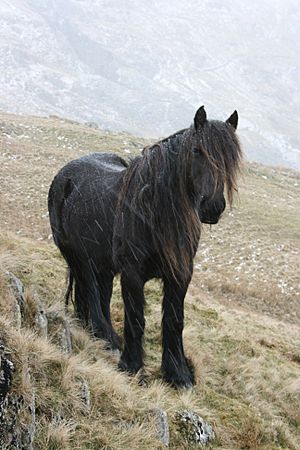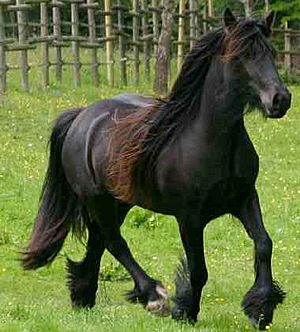Fell pony facts for kids

A black Fell Pony
|
|
| Distinguishing features | Sturdy, feathered legs |
|---|---|
| Country of origin | Cumbria, England |
| Breed standards | |
| Fell Pony Society | Breed standards |
| Fell Pony Society of North America | Breed standards |
| Horse (Equus ferus caballus) | |
The Fell Pony is a strong and helpful breed of pony that comes from the mountains and moorlands of northern England. These ponies were first used on farms in Cumberland and Westmorland. Today, people use them for riding and for pulling carts.
The Fell Pony is quite similar to its neighbor, the Dales Pony, but it's a bit smaller and looks more like a traditional pony. Fell Ponies are known for being very tough, quick, strong, and good at walking on tricky ground.
Contents
What Makes a Fell Pony Special?
Fell Ponies come in different sizes and weights. This means they can carry almost any rider! Most Fell Ponies are about 13.2 hands (54 inches, 137 cm) tall, and they can't be taller than 14 hands (56 inches, 142 cm). They were raised in the tough, mountainous area of Cumbria in northwest England. This makes them able to live well in almost any mild climate.
Colors and Markings
Fell Ponies can be black, brown, bay, or grey. Sometimes, they can be chestnut if both their parents are registered. Ponies with large patches of two different colors (like piebalds or skewbalds) are not allowed. It's okay for a Fell Pony to have a small white star on its head or a little bit of white on its back fetlock (the part of the leg above the hoof). However, too much white is not preferred.
Temperament and Movement
Fell Ponies are very hardy and show good pony traits. They have strong bones and are smart. They are also known for being alert and lively. Generally, this breed has a calm and steady personality.
Fell Ponies have regular gaits (ways of moving). They are known for moving correctly and are very sure-footed, even on rough land. This makes them great for exploring trails!
Agility and Jumping
Fell Ponies are good at jumping and are very agile. This makes them useful for cross-country riding or hunting. While most Fell Ponies might not be top-level jumping stars, they are usually good enough for local shows or Pony Club events.
History of the Fell Pony
The Fell Pony shares its early history with the Galloway pony, which is now extinct. The Galloway pony was also an ancestor of the Dales Pony. It's thought that Fell Ponies first appeared on the border between England and Scotland, possibly even before the Romans arrived. The Fell Pony Society doesn't claim that Roman war horses were mixed with these ponies.
When the first records of Fell Ponies were made, about half of them were brown. But over the last few decades, black ponies have become the most common. Brown, bay, and grey ponies are also seen.
Fell Ponies are mainly working ponies. They are active, have lots of stamina, are tough, and smart. These qualities help them live and do well in the difficult conditions of the fells (open moorlands) in the Lake District.
Fell Ponies as Packhorses
Originally, the Fell Pony was used as a packhorse. They carried heavy materials like slate, lead, copper, and iron ore. They also helped with farm work and moved bulky farm goods like wool. With their strong bodies, powerful legs, and calm nature, they were good, fast walkers. They could travel up to 240 mi (390 km) in a week!
The Vikings liked Fell Ponies for carrying goods, ploughing fields, riding, and pulling sledges. Their use as pack ponies continued into the 1900s. They were even used in pack-pony trains and by postal services to deliver mail. Some Fell Ponies in the north were famous for being fast trotters. There are many stories about how quickly these ponies could cover long distances.
Fell Ponies Today
Today, Fell Ponies are used for many things. People enjoy them for pleasure riding, competitive sports, pack-work, trekking, and helping with shepherding. You can see Fell Ponies at horse shows, where they compete in classes like "in hand" (judged while led), under saddle, and working hunter pony. They also do well in driving events and endurance riding. Because of their calm nature, they are very good for riding and driving for people with disabilities.
A Fell Pony can be a great all-around family pony. It can carry both children and adults. It's also versatile enough to do many different jobs that might otherwise need two or three specialized animals. The growing popularity of carriage driving as a hobby has given the Fell Pony a new purpose, similar to the work they did for centuries.
A few Fell Ponies are still used in Scotland to carry stags and grouse (types of birds) down from the moors. Some of the ponies belonging to Queen Elizabeth II are sometimes used for this at Balmoral Castle. Other royal Fell Ponies are used for riding and driving by the royal family. Recently, Fell Ponies have also helped carry equipment into the hills to repair footpaths in the Lake District. They are also increasingly used in British Dressage "Team Quest" competitions.
The Fell Pony Society
The Fell Pony Committee decided to form a society in 1916. Their goal was "to keep pure the old breed of pony that has roamed the northern hills for years." After World War I ended, this idea became a reality. In 1922, the society changed its structure to attract more members and support the Fell Pony.
However, the number of ponies still went down quite a lot until 1945. At that time, a breeding program was started to help the breed grow. This program ended in 1970. In the 1950s, riding for fun became popular, which helped secure the future of many native British horse breeds. The number of ponies being registered with the Fell Pony Society has slowly increased since then.
All Fell Ponies are registered through the society. They publish a yearly stud book (a record of all registered ponies). The patron of the society is Queen Elizabeth II.


